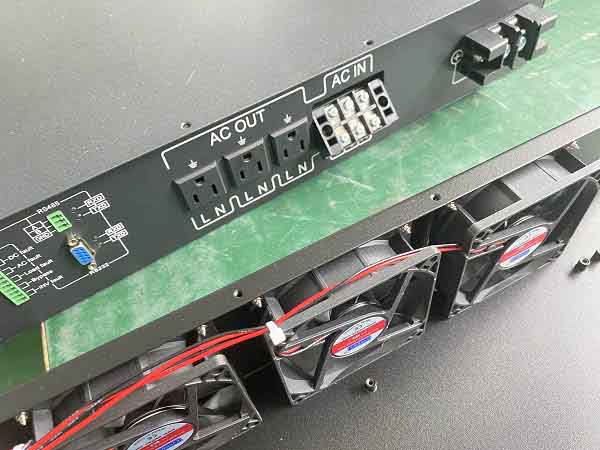A design of intelligent inverter power supply, novices can also learn
With the development of modern electronic technology and power supply technology, inverter power supplies have gradually become the first choice for electronic circuit power supplies with the advantages of small size, light weight, high power, high integration, and convenient output combination. In the actual working environment, especially in some industrial sites, the electromagnetic environment is very harsh, and abnormal situations often occur, such as overvoltage, transient pulse shock wave, strong electromagnetic radiation, etc., which may destroy the power supply and affect the entire system work. Next, Powerwit's "transparent" power supply detection technology with microprocessor as the core is supplemented by means to improve the switching power supply's anti-overvoltage and anti-interference performance, and an inverter power supply with protection and monitoring functions is designed.

1 Design ideas
With the increasing requirements of electronic equipment for power supply systems, it is increasingly necessary to study inexpensive switching power supplies with functions of monitoring and managing power supplies. Based on the comprehensive consideration of the various technical performance of the power supply, its own safety requirements and the performance of the switching power supply, this article has designed a new and practical intelligent power supply with overvoltage detection and protection devices. It has the following characteristics:
(1) The overvoltage is actually detected, and the instantaneous value and peak value of each overvoltage can be recorded, and the backup power supply can be started to protect the electronic circuit.
(2) It has the characteristics of strong impact resistance, long service life, and digital monitoring with LCD screen. At the same time, it can realize the function of "transparent" power supply and protection through RS485 communication interface and management computer communication.
(3) Real-time display of output voltage and current, the number and magnitude of overvoltage, and necessary parameter setting information.
(4) Realize data transmission with the background or remote PC through the interface.
The core of the intelligent power supply consists of a display board, a CPU board, a communication board, a backup power board, an overvoltage detection board, a keyboard, and a communication adapter board. The key of the device is to realize the voltage peak detection, especially the detection of overvoltage. This article proposes a single-chip-based over-voltage detection and peak voltage detection method, and the experiment proves that it meets the requirements for detection speed and accuracy.
2 System hardware design
The system hardware framework is shown as in Fig. 1. Under normal circumstances, the 220V AC input voltage can be rectified, filtered, DC/DC converted, and stabilized circuit to get a stable output voltage, which is basically a switching power supply; when there is an overvoltage, the overvoltage signal passes through The overvoltage detection circuit detects and holds the peak voltage holding circuit, controls the power circuit, disconnects the normal working AC circuit, and starts the standby power supply through the computer at the same time, and completes the measurement of the instantaneous value and peak value of the overvoltage.
2.1 Overvoltage detection circuit
Overvoltage is a very harmful signal for the power supply. If the instantaneous high voltage caused by thunder and lightning is not suppressed, the direct introduction of RTU (remote terminal equipment) from the power supply will affect the normal operation of the power supply module and make the function of each functional module The working voltage rises and the working is not normal. In severe cases, the module will be damaged and the components (IC) will be burned out.
The basic principle of over-voltage protection is to detect this signal through an over-voltage detection circuit when a transient voltage occurs (micro-scale or nanosecond level). The main component in the overvoltage detection circuit is a varistor. The varistor is equivalent to a lot of bidirectional suppression diodes connected in series and parallel. When the voltage exceeds the clamping voltage, the varistor is turned on; when the voltage is lower than the clamping voltage, the varistor is turned off. This is the voltage clamping function of the varistor. The varistor works extremely fast, with a response time of nanoseconds.
When an overvoltage signal is generated, the varistor is broken down, showing a low resistance or even close to a short-circuit state, so that a large current is generated in the primary stage of the current transformer, and a small current is generated in the secondary stage through the mutual inductance of the coil. The current signal is converted into a voltage signal through a precision resistor; after this signal is input to the voltage comparator LM393, the voltage comparator LM393 outputs a high level, and the control pulse 1 output by the NOT gate A controls the power circuit, disconnects the switching power supply circuit, and starts backup power. The control pulse 2 is sent to the interrupt of the single-chip microcomputer, and the single-chip microcomputer controls back to start the A/D conversion and sample the instantaneous value of the overvoltage.
2.2 Peak voltage sample and hold circuit
The peak voltage sample-and-hold circuit consists of a sample-and-hold chip LF398 and a voltage comparator LM311. The output voltage of LF398 is compared with the input voltage through LM311. When Vi>V0, LM311 outputs high level and sends it to the logic control terminal 8 of LF398 to make LF398 in the sampling state; when Vi reaches the peak value and drops, Vi< V0, the voltage comparator LM311 outputs a low level, and the logic control terminal of LF398 is set to a low level, making LF398 in a holding state. Since the LM311 uses an open collector output, it needs to be connected to a pull-up resistor. The pulse sent from the output terminal of the over-voltage detection circuit controls the conduction of the circuit switch. When there is no over-voltage, the sampling capacitor is discharged, otherwise the sampling circuit has been tracking the change of the peak value.
The above is the professional information provided by bwitt, I hope it will help you.

